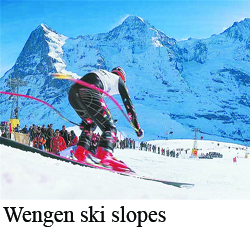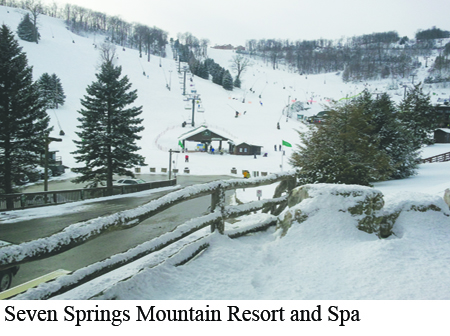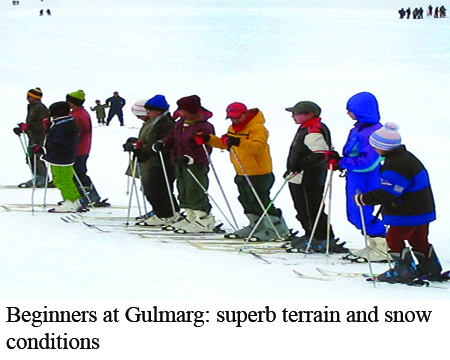The ski run from Alparbat to Tangmarg (on the road from Gulmarg to Srinagar), is probably one of the longest in the world from 14,000 ft to 4,000 ft. Experts have categorised it as potentially the best ski run on the planet. Rahul Singh reports
 Which is the fastest growing sport worldwide since the 1960s? It’s not football, tennis or golf, and certainly not cricket which is seriously played by less than a dozen countries. The answer won’t stump westerners, but Indians are bound to be taken aback, because few of them know anything about this particular sport, and fewer still, indulge in it.
Which is the fastest growing sport worldwide since the 1960s? It’s not football, tennis or golf, and certainly not cricket which is seriously played by less than a dozen countries. The answer won’t stump westerners, but Indians are bound to be taken aback, because few of them know anything about this particular sport, and fewer still, indulge in it.
I’m talking about skiing — not water-skiing but skiing on snow. In the US currently there are 14 million active skiers, with another 13 million termed “potentials”. In Alpine countries like Switzerland and Austria, children are weaned on skis from an early age and skiing holidays are rites of passage for most European youngsters. The late J.R.D. Tata was an aficionado, and would visit the Alps every winter to ski, up until his seventies.
There’s been a phenomenal growth in ski resorts in recent years, especially in Europe and North America, as also in Japan, Australia, New Zealand and north Africa. In Beirut, Lebanon, you can swim in the ocean in the morning, drive up the nearby mountains and ski the same afternoon. Skiing facilities are available in the most unlikely places these days — at a price, of course. In the desert city state of Dubai, you can ski on an artificial surface replicating snow.
I donned my first pair of skies in the mid-50s, when my father was working with Unesco in Paris. I was then 14 years old and the resort we chose was Wengen, in the Swiss Alps. It still is one of Europe’s principal ski resorts (others include Davos, Chamonix, St. Moritz, Zermatt, Zurs, Innsbruck and Kitzbuhel), with slopes for beginners, intermediate skiers, and experts. Ski-lifts, chair cars and gondolas, transport skiers to varying heights, depending on their skill and capability.
For a beginner, the first couple of days are the most challenging, and dangerous. You have to be prepared to take some tumbles from the moment you put on your skis and start moving forward. That’s when most beginners lose their balance and fall. Worse, if your ski tips get crossed, you’ll be propelled forward and fall flat on your face with your upturned skis jutting skyward. For spectators, it’s a comical sight, but it’s humiliating and painful for skiers. You could wrench your ankle or even break a leg. It’s common to see people in resorts hobbling about on crutches, with their legs or ankles in plaster.
Luckily I didn’t suffer any serious injury in my first attempts on the slopes of Wengen. But in case of an unlucky injury, there’s always the joy of the apres ski (French for after skiing) option. This is the lively night life of ski resorts teeming with bars, restaurants and discotheques, where romance blossoms easily. In fact, there are many people who visit these resorts only to enjoy the panoramic vistas and apres ski activities.
Returning to the sport, once you are able to maintain your balance and learn to slow down and turn — a manoeuvre known as the ‘snow plough’ — you’ll get downright hooked to skiing. After the tentative beginners stage, you grit your teeth and take on steeper and trickier slopes and ski fast and faster.
Within a few days, neophyte skiers can easily reach speeds of 50-60 kph. But it’s not just the speed at which you swish over the snow that makes this sport so exhilirating; it’s the whole package — the mystique of the moun-tains around you, the crisp cold air tingling the skin and your skies hissing through powdery snow — that makes it such a unique experience. You’re on your own, communing with nature, while exerting every part of your body — legs, arms and torso. The mountains dwarf you and the ever-present element of danger gives the sport an added, thrilling edge.
Since my first skiing holiday in Switzerland, I have skied in the French and Austrian Alps, the Spanish Pyrenees, in the US (sadly not in Aspen, America’s most famous resort, but near New York and Washington, D.C.), even in Scotland (the UK has no ski resorts worth the name but Scotland has tolerable slopes and rudimentary ski-lifts).
 The resort near Washington I visited about a decade ago is named Bryce, a weekend getaway for wealthy and retired Americans. My late friend, Werner Fornos, invited me to his villa there. Bryce has some hills and though it’s known to record scanty snowfall in winter, modern technology has been invoked. When the weather gods are unkind and the snowfall slackens or doesn’t occur, Americans create their own snow! For this, the environmental temperature has to be right, close to freezing or, better still, below freezing point. The colder the better. Compressed air and water is loaded into ‘snow guns’, a mini cannon-like contraption aimed heavenwards, and the mixture is fired into the sky. The droplets emitted merge with the cold air, freeze and turn into snow, which falls gently to the ground.
The resort near Washington I visited about a decade ago is named Bryce, a weekend getaway for wealthy and retired Americans. My late friend, Werner Fornos, invited me to his villa there. Bryce has some hills and though it’s known to record scanty snowfall in winter, modern technology has been invoked. When the weather gods are unkind and the snowfall slackens or doesn’t occur, Americans create their own snow! For this, the environmental temperature has to be right, close to freezing or, better still, below freezing point. The colder the better. Compressed air and water is loaded into ‘snow guns’, a mini cannon-like contraption aimed heavenwards, and the mixture is fired into the sky. The droplets emitted merge with the cold air, freeze and turn into snow, which falls gently to the ground.
Depending on the temperature, you get from one to several inches of snow in an hour. So, even if there isn’t a cloud in the sky and the sun is shining, enough snow for skiing can be produced over a large area, using snow guns. That’s how hundreds of us skied for three days in Bryce.
Much the same happe ned more recently, again in the US. The Seven Springs Mountain Resort and Spa is a two-hour drive from Pittsburg. Located in the Laurel Highlands of Western Pennsylvania, it turned out to be just perfect (in summer, the resort transforms into an 18-hole golf course). I booked a three-night package, which included room, breakfast, ski and boots hire, plus complimentary ski-lifts for three days. The package deal, booked online, was reasonably priced, even by Indian standards.
ned more recently, again in the US. The Seven Springs Mountain Resort and Spa is a two-hour drive from Pittsburg. Located in the Laurel Highlands of Western Pennsylvania, it turned out to be just perfect (in summer, the resort transforms into an 18-hole golf course). I booked a three-night package, which included room, breakfast, ski and boots hire, plus complimentary ski-lifts for three days. The package deal, booked online, was reasonably priced, even by Indian standards.
The resort has a huge 414-room hotel, with bars, restaurants and shops. I put my skis on and headed straight to the slopes. I hadn’t skied for over a decade, and lost my balance a couple of times, but my skills quickly resurfaced. I took the ski-lift to the top of the hill, a height of almost 3,000 ft and skied down to the bottom, a distance of almost 2 kms. What bliss! Evenings were spent at the bar, making friends with strangers who had never seen an Indian at the resort, but many of whom had been treated by Indian medical practitioners! Seven Springs had a sprinkling of natural snow at the time, supplemented by snow created by snow guns fixed on the slopes which covered 300 acres.
In India the British began skiing on the slopes of Kufri, near Shimla in the 1930s. However, due to global warming and deforestation, Kufri does not receive as much snow as it used to. Yet the epicentre of skiing now is Gulmarg in Kashmir, 52 km from Srinagar, a two-hour car or bus drive. I first skied there with three friends in the mid-60s. We were the only civilian skiers staying at the only hotel open in winter — Highland Park, run by the Needou family. A High Altitude Warfare School (HAWS) was also sited there, with a young officer, P.N. Hoon, in charge (he went on to become a senior general and reportedly masterminded the Indian takeover of the Siachen Glacier). Starved of conducive company, he would invite us to dine at his army mess every evening, an offer we gladly accepted.
There were no ski-lifts then in Gulmarg and one had to hire porters to lug skis and trudge up the slopes on foot, which was pretty arduous. It took two hours to climb up to Khilinmarg, about 2,000 ft above Gulmarg’s 8,000 ft. Skiing back from Khilinmarg to Gulmarg took just 15 minutes. One could trek to Alparbat — almost 14,000 ft — overlooking the Pakistan border below. That climb takes four hours.
 My next visit to Gulmarg was a decade later in the mid-70s. A modest ski-lift had by then been constructed, drawing a fair number of tourists. Then came the Kashmir insurgency in 1979 and Gulmarg virtually closed down for almost two decades. In the past few years, it has re-opened and a gondola ride takes you to Alparbat. The ski run from Alparbat to Tangmarg (on the road from Gulmarg to Srinagar) is one of the longest in the world, from 14,000 ft to 4,000 ft. Experts have categorised it as potentially one of the best ski runs on the planet, with excellent terrain and superb snow conditions. Gulmarg, which also has a magnificent 18-hole golf course, could be a huge tourism earner for the cash-strapped state government, for use throughout the year.
My next visit to Gulmarg was a decade later in the mid-70s. A modest ski-lift had by then been constructed, drawing a fair number of tourists. Then came the Kashmir insurgency in 1979 and Gulmarg virtually closed down for almost two decades. In the past few years, it has re-opened and a gondola ride takes you to Alparbat. The ski run from Alparbat to Tangmarg (on the road from Gulmarg to Srinagar) is one of the longest in the world, from 14,000 ft to 4,000 ft. Experts have categorised it as potentially one of the best ski runs on the planet, with excellent terrain and superb snow conditions. Gulmarg, which also has a magnificent 18-hole golf course, could be a huge tourism earner for the cash-strapped state government, for use throughout the year.
Skiing is also possible in Auli and Solang in Himachal Pradesh, both of which have great potential to attract high-end tourists. Indeed, seven years ago, John Sims, a billionaire American hotel developer, identified a valley in Himachal as the perfect place to build India’s first western-style ski resort over 150 acres. He was willing to invest $500 million in the project, a proposal accepted by the state government, with Sims offering a hefty deposit.
The state government then changed hands and typically, some ridiculous objections were raised. The project remains in limbo, an opportunity for cashing in on the world’s fastest grow-ing and big-earning sport, squandered.